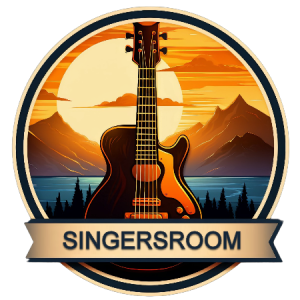The pan flute is a little charming musical instrument.From South America to China, to Ancient Greece, the world has utilized it for entertainment, therapeutic, and physical strength reasons. Like other musical instruments, playing a pan flute on a regular basis is insanely therapeutic, helps to keep your brain feeling energetic, and simply inspires self-confidence. It also teaches you a lot about breath control. By blowing some air through its inner edges, you can create a series of melodious tunes. The soothing and beautiful sound produced by a flute is certainly something to look forward to.
The best part is that it is quite easy to learn how to play a panpipe. If you are starting out, there are a plethora of entry-level flutes for you to practice with. For intermediate and expert players, the market is full of professional pan flutes as well. However, finding the right fit for you is an all-important step towards success. Walk with us as we review the top pan flutes for 2023 below.
Contents
- 1. Cusco QT-21 3-Octave Panpipes
- 2. Bamboo Pan Flute
- 3. Panflute Percussion Woodwind Instrument
- 4. Woodstock Chimes WOODKPANL Pan Flute
- 5. Pan Flute 15 Pipes Tunable Natural Bamboo from Peru
- 6. Zampona Pan Flute – Traditional Design
- 7. 16 Pipes Eco-Friendly Resin C Tone Pan Flute Easy Learning
- 8. Beautiful InkaTumi Decorative 13 Pipes Curved Pan Flute
- 9. Pan Flute Set of Three Sizes Hand Made in Peru
- 10. Easy to Play Beginner Peru Treasure Tunable Antara Pan Flute 13 Pipes
- Pan Flute Selections Tips
- Types of Pan Flutes
- Top Pan Flute Brands
- Average Pan Flute Pricing
- Questions and Answers
1. Cusco QT-21 3-Octave Panpipes
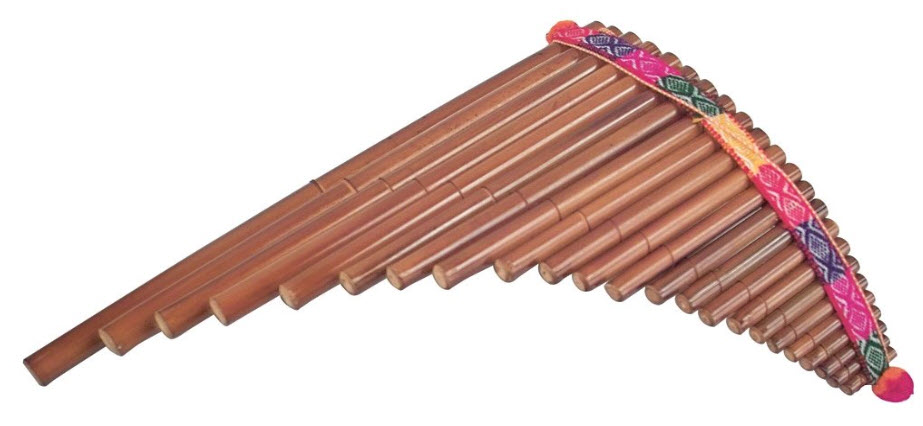
One of the best pan flutes in the market right now is the 3-Octave panpipe from Cusco. South Americans love this masterpiece and use it to produce their authentic folk sounds. No doubt this woodwind musical instrument will introduce a sweet rhythm to your home.
The original octave panpipes were hand-crafted in Peru by skilled workmen for uses in many parts of the world. The Cusco QT-21 3-Octave Panpipe is also made by Peruvians and utilizes pretty much all the materials and techniques of the original flutes. From the name, the instrument features a curve style with a 3-range octave. It has a total of 23 canes of length and a curve size of 17-inches long and 12-inches wide. The panpipe is characterized by a pleasant, refined, and artistic design that sets it apart from other flutes of the same price range ($25.88 on Amazon).
Pros
• Features a sleek, pleasant design
• Produces authentic tones
• Affordable
• Good for a beginner
• Comfort while playing
• Handcrafted with care
Cons
• Limited note variation (all notes are flat except one F-sharp)
• Needs a tuner before use
2. Bamboo Pan Flute
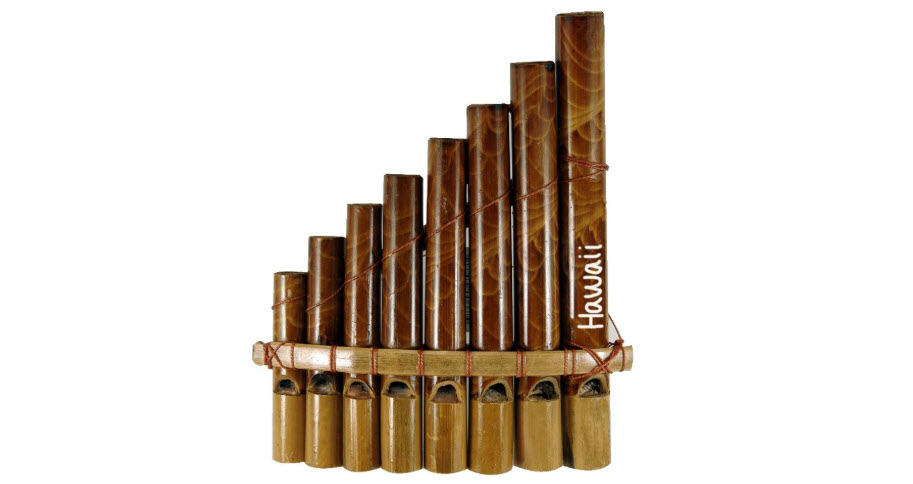
Secondly, the Bamboo Pan Flute made from authentic bamboo materialshas a unique gloss. It is a curved handmade instrument with origins in Indonesia. With a total of 8 pipes, the pan flute if a perfect fit for novice players looking to flex their respiratory muscles. Although rhythmical and beautiful, the sound produced by the Bamboo Pan Flute is not much compared to other flutes in the market. For this reason, it is not used in professional capacities by many people. Often, the instrument is used as a souvenir or a toy and not for serious use. As a matter of fact, the manufacturers of this flute insist that the instrument is not made with professionals in mind. It does produce some sound but not something substantial for professional use. It is particularly great for kids.
However, its unique design sets it on a high pedestal among other pipes. Its craftsmanship is simply a beauty to behold. Basically, the instrument doesn't have a particular toy and works best for playability rather than its sound. Bamboo Pan Flute weighs 0.32 ounces and measures 5.9 x 4.6 x 1.5 inches.
Pros
• Somewhat affordable
• Features a nice construction
• Simple to use
Cons
• Although nicely crafted and decorated, it produces limited sounds
3. Panflute Percussion Woodwind Instrument
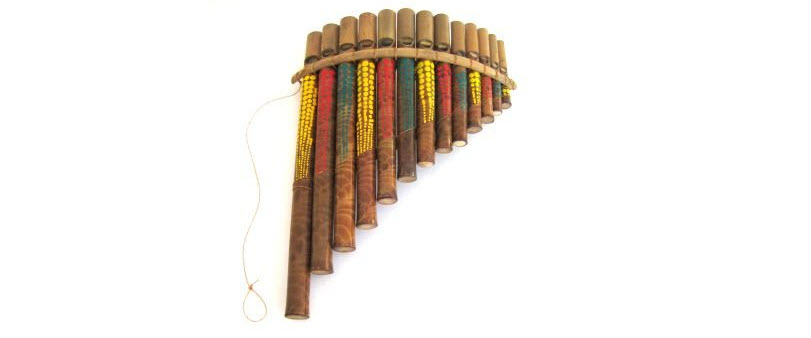
The Panflute Pan Flute Panpipes Percussion Woodwind Instrument from Jive is skillfully handcrafted by artisans using Bamboo. With 13 pipes lined in a concave shape with each pipe being shorter than the next, the flute is great for just about any music enthusiast. The arrangement of the pipes makes the instrument produce a unique, melodious pitch. The dimensions are approximately 11 x 9 inches with a weight of 6.4 ounces. The price of the Panflute Pan Flute varies per item. You can choose a painted of a plain appearance, both of which have a direct impact on the price of the item.
Pros
• Gives you options to choose from
• Produces a unique sound
• The pieces are pretty tight
• Relatively cheap
Cons
• Limited in precision ( tuning is not a walk in the park)
4. Woodstock Chimes WOODKPANL Pan Flute
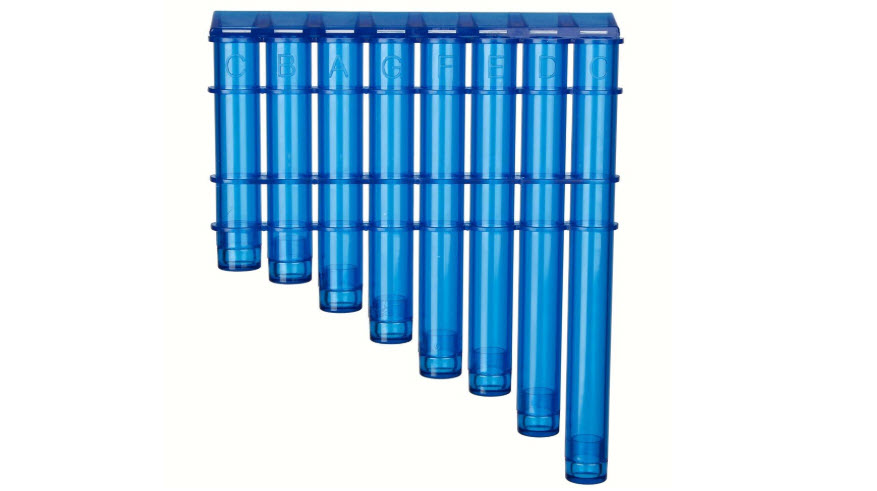
This is one of the oldest panpipes dating back to ancient Greece. According to Greek Mythology, the god Pan created and played a cane flute to reminisce his lost love.
The modern Woodstock Chimes comes in a striking bright blue color that instantly steals the attention in the room. Made from a plastic material with eight notes, the instrument is also quite easy and fun to play. It has a dimension of 5.5 x 5.5 x 6.8 inches and weighs about 5.6 ounces that help it fit well into any set of hands. Being playable, attractive, and affordable, the unique musical instrument is a great fir for beginners and kids.
The Woodstock Chime produces a ton of melodies when blown. Depending on the level of intonation, the panpipechurns out a beautiful, safe, and distinctive sound that is full of life.
Pros
• Perfect for young children with an interest in playing flutes
• Excellent materials
• Affordable
• Great tone
• Tunable
Cons
• Difficulty when blowing into pipes and notes
• Too small for an adult-sized hand
• Doesn't hit low notes that professionals are after
5. Pan Flute 15 Pipes Tunable Natural Bamboo from Peru

The Tunable Pan Flute is another leading woodwind instrument in the market, especially in the beginner category. It is made from natural bamboo with 15 inches and dimensions of 7.1 inches long and 7 inches wide. The selling pointof this musical instrument is the tunable feature that makes it possible for a user to modulate sound. Although it is ideal for starters, many steady players of all levels find the flute quite beneficial as well.
The pan flute is tuned to the C key and has a weight of 3.2 ounces and a frequency of 440 Hz. Apart from indoor uses, a Tunable Natural Bamboo Pan Flute can also be used for various outdoor applications also including camping, scouting, and other small gatherings. It produces a nice melody and is relatively easy to play.
The musical instrument is produced from quality materials for durability. The frame is also characterized by distinctive channels for better tuning accuracy.
Pros
• Easy to play
• Durable, made from non-toxic materials
• Great for kids, beginners, and advanced players
• Quality construction
• Great tuning accuracy
Cons
• Is limited in frequencies (it is more of a soprano)
• Not easy to tune
• Some folks find it too small
6. Zampona Pan Flute – Traditional Design

This handcrafted traditional masterpiece makes it to the top 10 list both for producing an attractive sound and featuring a beautiful look. The Zampona Panflute is designed by skilled craftsmen from Peru, so you can expect it to be quality and effective at sound production. It is made of Andean Bamboo and has a line-up of 13 pipes with increasing lengths. The ancient instrument works on the principle of the closed tube. It has been a popular choice as for folk musicians with the original versions being made from giant cane.
The charming look of the flute combined with the ease of use makes it a fantastic instruments for kids with a desire to learn the basics before advancing to other levels. The sound produces by the tightly-closed pipes is perfect for church services, fundraising events, scouts, camps, and other small gatherings.
Pros
• Charming to look at
• Perfect for beginners and kids
• Has good intonation and a proper embouchure
• Affordable
Cons
• Not ideal for high-performing gigs
• Difficult to tune
7. 16 Pipes Eco-Friendly Resin C Tone Pan Flute Easy Learning
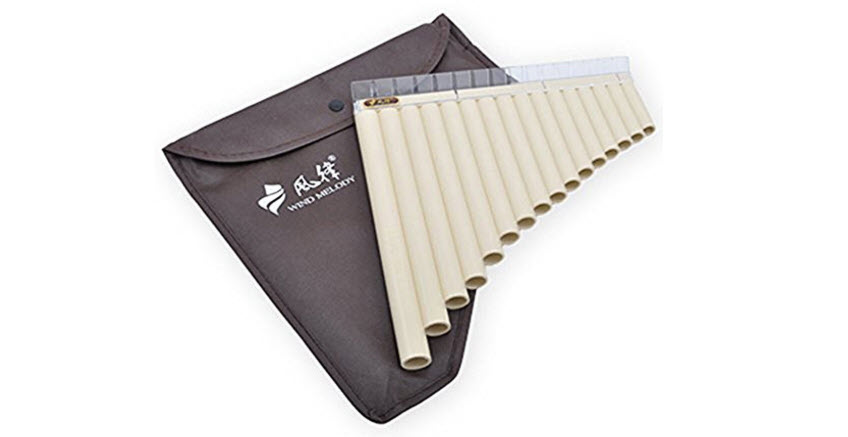
From the name, you already know this is a good flute for a learner. If you are hoping to have a panpipe to practice with, this is the flute to opt for. The creators created the panpipe for novice players who want to grasp the basics before moving on to advanced pan flutes. The instrument measures 23cm in width and has 16 pipes ranging from 6cm to 26cm in length.
The 16 Pipes Eco-friendly Pan Flute uses a non-toxin material for construction that is friendly to the environment. It weighs 240g and is tuned to key of C. Even without a manual and thorough instructions, anyone can learn to play this pan flute in record time. It also comes with a beautiful finished edge and a rounded side design with perfect packing of the pipes.
Pros
• Good pronunciation
• Decorative ivory finish
• Environmentally-friendly
• Easy to play
Cons
• Offers very little for a professional player (lacks vibrators and accidentals)
8. Beautiful InkaTumi Decorative 13 Pipes Curved Pan Flute

The InkaTumi flute is a quality musical instrument with a nice melody production. It is made from bamboo with a frequency of 440Hz and tuned to the key of G major. Its dimensions are 51/2 inches long and 13/4 inches wide. Like the 16 Pipes Eco-Friendly Resin Pan Flute, this one is easy to learn, thanks to its simple design. The accompanying features make learning hassle-free and less time-consuming. Although the instrument produces good sound, it is better played alongside other instruments for an overall performance.
Pros
• Aesthetically-pleasing ( beautiful Inka Motifs Design)
• Easy to play
• Works well for both adults and kids
• Produces a fine and mellow tune
Cons
• Though well-crafted and designed, it doesn't produce great sounds
9. Pan Flute Set of Three Sizes Hand Made in Peru

This handcrafted pan flute set extracted from the Peru Fair Trade is a fantastic instrument for all types of musicians. Whether you want to enter the world of music or want to simply advance your skills, you will love playing this pan flute combo. The set features 8", 5", and 3"sizes, all made from a bamboo-like material known as Carisso which is harvested along the shores of Titiaca Lake in Peru. The instrument weighs 11 ounces with dimensions of 12 x 10 x 3 inches. Children with a love for playing wood pipe instruments will certainly love blowing on this pan flute. It is ideal for schools, fundraisers, camps, scouts, and church activities.
Pros
• Quality sound on all sizes
• Great for beginners and children
• Originally handcrafted in Peru
Cons
• Too simple for expert players
10. Easy to Play Beginner Peru Treasure Tunable Antara Pan Flute 13 Pipes
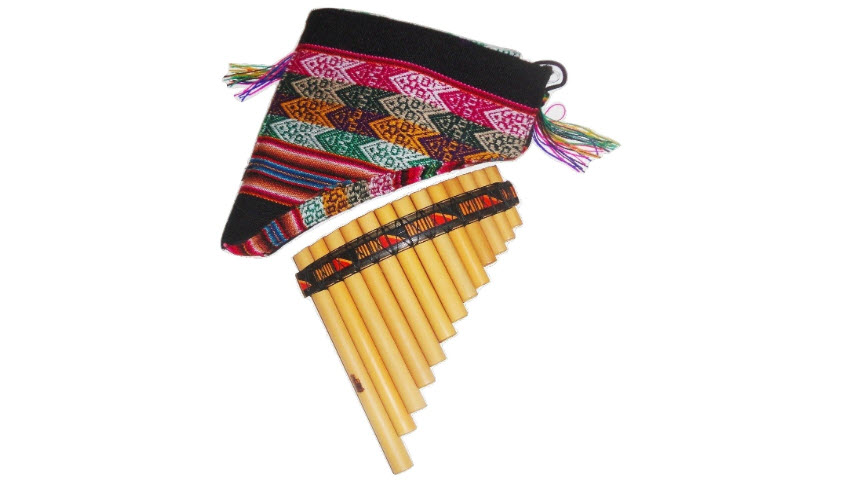
We wrap up this list with this masterpiece from Peru Treasure made from refined Bamboo. The Pan Flute just so happens to have been a widely-used musical instrument in Andes for over a century. The ancient panpipe consists of 13 pipes of graduating length, closely bound together in a beautiful design. Although the flute is tuned in E minor, each pipe can be tuned into a different key to produce a varying, rich sound. The pan pipes from the Peru treasure measure approximately 11.5 inches long and 5 inches wide. They are universal instruments of excellence, reminding us of old times and the wealth of diversity in the corners of the earth.
Pros
• Come s with a beautiful case
• Tunable
• A historical instrument with a reputation for quality
• Nice quality
• A wide range of notes
• Sturdy construction
• Easy to play
Cons
• Difficult to navigate for rookie players
Pan Flute Selections Tips
You need to find the right panpipe for your needs. You should balance between ergonomics and aesthetics when selecting a pan flute.
1. Skill Level
Your skill level will determine the ideal panpipe. If you are a beginner, you need something basic. Experts can opt for advanced instruments.
If you want to learn how to play the panpipe and you do not have much music background, an inexpensive pipe will suffice. You do not have to spend hundreds of dollars buying a professional pipe if you are a novice. An experienced musician can opt for a costly instrument.
2. Number of Pipes
The number of pipes in a panpipe can range from 5 to 15. Each pipe will produce a distinct and beautiful sound. A panpipe with many pipes is complex to play. Therefore, it is ideal for an expert.
· Purchase a panpipe with less than or equal to two octaves if you want to easily understand the movement between pipes. Using such a panpipe will help you to improve your skills quickly. An instrument with more than two octaves is complex to play.
3. Tunable Feature
When selecting a pan flute, you need to choose between a tunable and a non-tunable panpipe. With the tunable feature, you can change the tuning depending on the sheet or song that you are working on. This feature is useful for beginners. If a non-tunable flute gets out of tune, it is only an experienced player who will be able to fix it.
4. Is the Panpipe Tuned with Wax or Corks?
The best way of tuning a panpipe is by using wax. Panpipes tuned with wax can be returned fairly quickly. For those tuned with corks, it is difficult to change the tuning. Some panpipes have sliding plugs in the bottom for changing keys.
5. Ergonomic Design
You need an ergonomic panpipe. A curved pipe is ergonomic for the natural turn of the head. Some straight pipes are also ergonomic.
6. Aesthetics
You should consider aesthetics when selecting a pan flute. The best flutes have a great appearance because they are made from high-quality materials.
7. Handmade or Mass Produced
You need a handmade panpipe that has been made by a professional artisan. Such a pipe is well-tuned and will be useful for playing. A handmade panpipe has quality construction while a mass-produced pipe has poor construction.
8. Consistency in Construction
A good pipe has consistent construction. All tubes are of the same size and have been made using the same materials.
9. Length and Diameter of the Pipes
The ratio between the length and diameter of the pipes matters. A narrow tube will produce a sound with a high content of upper harmonics. A fat tube of the same length will produce a rounded sound. An extremely narrow tube produces the fundamental note mixed with the harmonics.
10. Material
Bamboo is the best material for making panpipes. Bamboo construction is aesthetically pleasing and also gives the pipe its traditional sound. Other materials that can be used include metal, ceramics, and reeds.
The material that has been used will determine the durability of the pipe. A pipe that has been made of clay or ceramics can easily break.
11. Size and Weight
A big panpipe will be difficult to play. It is easy to hold a light pipe. Such a pipe can even be played by a child.
Types of Pan Flutes
1. European Pan Flutes
All European pan flutes are derived from the syrinx. The syrinx was the most popular musical instrument in ancient Greece. It is as old as Greek civilization itself.
All European panpipes have the same basic structure. However, they have different names. In Romania, the panpipe is called Nai while in Turkey it is called Muskal.
· The Nai panpipe was invented in the 17th century and is commonly used in lautari bands. Famous Nai players include Gheorghe Zamfir, Damian Draghici, Constantin Moscovici, and Dana Dragomir.
· The Nai panpipe is curved and has a unique, swiveling design. It can create a wide range of sounds. The Nai pan flute has 22 pipes made of reeds or bamboo wood.
2. Andean Pan Flutes
The ancient Europeans were not the only ones to develop a pan flute-like instrument. Ancient panpipes have also been excavated in South America and some parts of Canada.
· Modern Andean panpipes include Antara, Siku, and Zampona. They are very popular in South America. To this day, Andean music is greatly influenced by pan flutes.
· Antara is the most popular Andean panpipe. It hails from the indigenous Amazonian tribes. It has 13 slightly curved bamboo pipes. These pipes create 13 different notes.
· The Siku is another popular Andean panpipe. This flute has 13 pipes made from bamboo wood. Its design allows two people to play one instrument.
· The Siku needs two people to play the whole scale. The traditional Andean Siku orchestra has twelve Siku. Playing the Siku is a true communal action. Large groups of Siku players can be found in Chile, Argentina, Peru, and Bolivia.
3. Chinese Pan Flutes
The ancient Chinese also developed panpipes. The Chinese panpipe was called the paixiao. This bamboo panpipe had 16 pipes arranged in a semicircular shape. This shape was inspired by the wings of the Fenghuang, which is a mythical Chinese bird.
There is evidence that the paixiao existed as early as the 6th century BCE. However, it became popular during the Tang Dynasty.
4. Wot
The Wot is a small, compact, and beautiful shaped panpipe used for playing traditional music in Thailand and Laos. It is typically made of bamboo. The standard Wot has 13 wood pieces and can produce four notes. There are four types of Wot: circular Wot, panel Wot, tail Wot, and tail swing Wot.
5. Larchemi
This is an ancient Georgian panpipe. In the past, it was largely found in Lazeti, Imereti, and Abkhazia. By 1960, it had largely disappeared. The Larchemi has a row of six reed pipes.
Top Pan Flute Brands
1. Peru Treasure
2. Moon Angel
3. Wind Melody Panpipes
4. Inka Tumi Bamboo Panpipes
Average Pan Flute Pricing
The average pricing of panpipes ranges from $19 to $60. The cheapest panpipes cost less than $10 while the most expensive cost over $100.
Questions and Answers
What is a Pan Flute?
A pan flute is a closed tube musical instrument with multiple pipes of gradually increasing length and girth. A panpipe is typically made from bamboo, reeds or giant cane. Other materials used for making panpipes include ivory, metal, and plastic.
How Does A Pan Flute Work?
A panpipe produces melodious sounds when someone blows horizontally through its open end. Sound is produced at the end of a resonating tube by the vibration of an air stream. Each pipe produces a different note. Therefore, you can perform an entire melody with a panpipe.
You can tune each pipe to your desired keynote. To produce old harmonic tones, you need to increase the pressure of your breathing to increase the tension of your lips.
With a Romanian panpipe, you can play sharps and flats. That requires a unique technique involving tilting the pipes and jaw movements.
There are two types of vibrators; hand vibrato and breath vibrato. When playing hand vibrator, you will cautiously apply a calm motion to a specific point of the panpipe. That is similar to how the violin vibrato is manipulated. Breath vibrato involves using your diaphragm. That is similar to playing any other woodwind.
What Was The Pan Flute Used For?
The pan flute was a popular folk instrument. It was associated closely with shepherds who played it while tending their flocks. It was used by shepherds to amuse themselves and soothe the sheep.
Where Are Pan Flutes From?
The origin of panpipes can be traced to the pre-Columbian period between 300 and 1500 AD. It originated from the ancient Mayan and Incan civilizations and spread throughout the Americas. Ancient man probably discovered sound production by blowing stems of plants such as reed and bamboo.
With time, cultures all over the world started creating their version of panpipes. In Europe, the Romanian panpipe became very popular. In most places, the panpipe was mainly a shepherd’s instrument.
The one pipe panpipe came first. The next step in the development of the panpipe was joining one pipe to another. After that, variations in form (straight, bundled, or slightly bent) started being made.
What Is The Best Pan Flute Brand?
The best pan flute brand is Peru Treasure. Peru Treasure panpipes are handmade in Peru with a design that honors the ancient Incan musical traditions. The Peru Treasure brand has excelled in producing top-notch panpipes handcrafted by talented Peruvian artists. These panpipes are produced ethically and sustainably.
Peru Treasure panpipes are ideal for players of all ages and skill levels. They have a stunning and colorful design. The simple design and subtle curves of a Peru Treasure panpipe make it easy to play.
Is A Pan Flute A Woodwind Instrument?
The panpipe is part of the woodwind family. That is because it requires air to be blown through it resulting in air vibrations inside the flute. The vibrations cause sound to come out of the flute.
